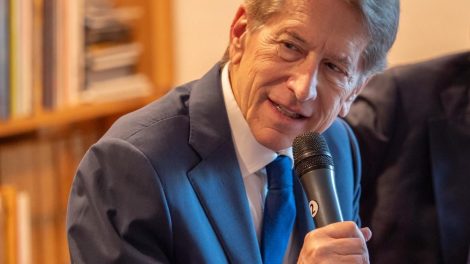As highlighted by Prime Minister Giorgia Meloni during her meeting with President Lee Jae-myung at the UN General Assembly, South Korea is one of the key pillars of Italy’s projection in the Indo-Pacific. Rome and Seoul share a pragmatic and complementary approach that combines regional stability, technological innovation, and supply chain security.
Between the lines: The Italy–Korea Business Forum — which gathered, in September, over 150 companies from the energy, semiconductor, and infrastructure sectors — confirmed the mutual ambition to turn economic cooperation into a long-term strategic partnership.
Why he Matters: Professor Moon Chung-in is a leading authority on South Korean foreign policy and inter-Korean relations. A Professor Emeritus at Yonsei University, he has long shaped Seoul’s strategic thinking through scholarship and public service. He served as Special Advisor to President Moon Jae-in for unification, diplomacy, and national security, chaired the Presidential Committee on Northeast Asian Cooperation, and acted as Ambassador for International Security Affairs.
Q: The new trade and investment framework between Seoul and Washington has been described as one of the most ambitious since the 2018 KORUS revision, combining tariff parity, strategic investments, and supply chain resilience. How do you assess the broader meaning of this agreement for South Korea’s strategic autonomy — especially in balancing economic cooperation with the U.S. and the emerging dynamics of a second Trump presidency?
A: South Korea proved that the U.S. cannot unilaterally dictate the nature and direction of bilateral economic relations. While believing that South Korea had become prosperous by “ripping off the U.S.” and that it should pay back, Trump adopted aggressive tariff policies. He first imposed a 50 per cent unilateral tariff on steel, aluminium, and their derivatives, effective from August 18, 2025, followed by 25 per cent reciprocal tariffs on all items from South Korea.
D: He also declared that the U.S. would apply additional high tariffs to semiconductor chips and pharmaceutical products. What’s more?
A: Trump then announced that he would lower South Korea’s reciprocal tariffs to 15 per cent on condition that South Korea purchases $100 billion of liquefied natural gas (LNG) and other energy products and sets up a $350 billion investment fund for shipbuilding, nuclear energy, and other manufacturing sectors.
- Worse still, Trump himself decides where funds are allocated and insists that the U.S. public receive 90 per cent of the return on investment. More importantly, Trump wants upfront cash investments.
- Compared with the Trump request for investments from the EU ($600 billion) and Japan ($550 billion), the South Korean share is relatively small, but it accounts for 82 per cent of Seoul’s total foreign reserves and 6.5 per cent of its GDP.
Q: Practically speaking, South Korea cannot afford to come up with this amount of cash up-front. And then?
A: However, South Korea’s tough bargaining led to a relatively fair outcome at the recent ROK-U.S. summit in Gyeongju. Of the $350 billion, the ROK will invest $150 billion in shipbuilding, led by South Korean firms that will combine cash, loans, and loan guarantees.
- For the remaining $200 billion, Seoul will invest up to $20 billion in cash annually for 10 years, with returns shared 50:50 between South Korea and the U.S. until the principal is fully recovered.
- In return, Washington lowered its 25 per cent reciprocal tariffs to 15 per cent, including on automobiles and components.
Q: How did Seoul manage to reach such a deal?
A: Compared with Japan, the South Korean deal reflects a more rational and fairer outcome. It also shows that the U.S. cannot unilaterally dictate its negotiations with South Korea, though unfair elements remain within the existing FTA framework.
Q: With the recent leadership transition in Tokyo, Prime Minister Takaichi appears to pursue a “realistic line” while maintaining a cautious approach on historical issues. Do you believe this new phase could foster a more institutionalised partnership between Seoul and Tokyo, or do historical and domestic sensitivities still risk undermining coordination on shared security and economic challenges?
A: It seems too early to make any judgment on the future of Japan-ROK relations under the Takaichi leadership. At a recent summit, Lee Jae-Myung and Sanae Takaichi agreed to enhance future-oriented bilateral relationships while paying attention to the past.
- They also agreed to promote cooperation in security, economy, society, and culture. However, what matters is not words but deeds. If Prime Minister Takaichi continues to pay tributes to the Yasukuni Shrine, denies Japan’s responsibility regarding the comfort women and forced labour issues, claims sovereignty over Dokdo (called Takeshima in Japan), and pushes for the revision of history textbooks — key tenets of the old Abe faction — the South Korean public will react angrily.
- President Lee cannot ignore such sentiments. What’s essential is Takaichi’s prudent, thoughtful, and empathic attitude toward the South Korean people on historical issues.
Q: The September meeting in Beijing between Xi Jinping, Vladimir Putin, and Kim Jong Un symbolically revived the triangle among China, Russia, and North Korea — for the first time in six decades. How should South Korea navigate this tightening bloc while seeking stability and dialogue with Pyongyang? And does this moment accelerate Seoul’s need to strengthen its deterrence posture within a broader multilateral framework alongside the U.S., Japan, and like-minded partners such as NATO?
A: I don’t think that Beijing, Moscow, and Pyongyang have revived the northern triangle axis through their leaders’ participation in the September 3rd victory parade in Beijing. It is true that since Pyongyang’s military support of Moscow in the Russia-Ukraine war, DPRK-Russia relations have become very close.
- However, China does not seem to want to form the northern triangle axis because it does not want a return to the old Cold War in Northeast Asia. If China joins such efforts, it will justify the creation of a southern triangle involving the U.S., Japan, and South Korea.
- For the same reason, South Korea does not want the return of an old Cold War structure that could undermine strategic stability on the Korean Peninsula and in Northeast Asia.
- While maintaining the ROK-U.S. alliance and the U.S.-Japan-ROK trilateral cooperation, the Lee government will seek to strengthen its strategic partnership with China and remain cautious in engaging with security cooperation frameworks, such as NATO.
The bottom line: As Washington and Seoul finalise a new trade and investment deal, Trump’s tariff diplomacy and the geopolitical dynamics are testing South Korea’s strategic autonomy.
Save the date: Professor Moon Chung-in will be in Rome on November 7 for a public lecture at the Guarini Institute for Public Affairs (6 p.m.), conducted by the Institute’s Associate Director, Professor Enrico Fardella.





